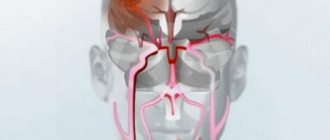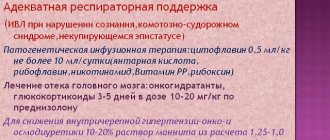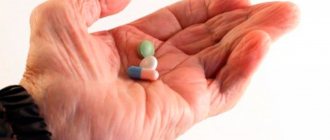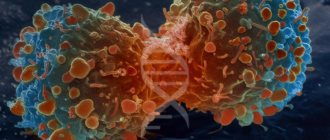- Reasons for rising temperature
- Temperature standard
- First aid
- Alternative antipyretic methods
- The patient's condition after a stroke
- Traditional medicine for stroke
Every year, several thousand cases of stroke are diagnosed worldwide. It is considered second after myocardial infarction among the most dangerous life-threatening diseases. During an attack, an increase in temperature is often observed, which indicates a high degree of dysfunction of the brain (BM).
Reasons for rising temperature
In a separate part of the brain, blood vessels become blocked, the blood supply is disrupted, and hemorrhage occurs, called a stroke. The walls of blood vessels are depleted, and high blood pressure leads to even more dire consequences when the vessels become permeable. In this condition, an aneurysm (dilation of blood vessels in the brain) can occur.
During an attack, the patient’s temperature may rise, so one of the first aid procedures is to measure it. The higher the temperature, the more extensive the part of the hemorrhage.
The causes of fever during ischemic stroke can be different:
- taking medications that cause allergies;
- exacerbation of chronic diseases;
- the presence of an inflammatory process (pneumonia, cystitis, etc.);
- viruses and infections;
- cerebral thrombosis.
Hyperthermia during a stroke leads to serious complications, in particular coma.
Causes of temperature after stroke in people
Symptoms after a stroke may include fever. Temperature after a stroke can have different causes and are discussed in this article. Stroke is a serious illness, often fatal. A high temperature after a stroke may indicate a poor prognosis.
According to statistics, men die from stroke more often than women. Therefore, every man should know the symptoms of a stroke. Signs of a stroke in a man are:
- sudden severe headache
- sudden weakness
- impaired coordination of movements,
- unsteady gait
- speech disorder,
- difficulty in perception,
- visual and hearing impairment,
- difficulty swallowing,
- numbness of the body on one side.
The listed symptoms of a stroke can be mild, short-lived and disappear on their own. But it is important to know that this may be the “first bell”, which may be followed by a real stroke. Therefore, even after a fairly mild attack, you should consult a doctor.
Main symptoms after a stroke
About half of stroke patients develop a fever. High temperature after a stroke - the causes are related to the initial severity of the disease and the size of the lesion. A high temperature after a stroke indicates a poor outcome, an unfavorable neurological outcome, and increases the risk of a second stroke and death.
Causes of fever after stroke: In most cases, it is a bacterial infection. Other reasons may be exacerbation of concomitant diseases, cerebral edema, bedsores, venous thromboembolism, brain necrosis.
Symptoms after a stroke depend on its severity. The disease can occur in a mild form, when consciousness is restored after a few minutes or hours, an intermittent form, or a progressive severe form, when a person regains consciousness after three or more days. In the first option, over time, subject to proper treatment and appropriate rehabilitation, all impaired brain functions are restored; in the case of an intermittent variant, restoration of most functions is possible, but there is also a danger of a recurrent stroke with subsequent complications; Progressive severe course of stroke most often leads to death.
Symptoms after a stroke, in fact, are already the consequences caused by complications of a cerebral stroke. These include severe symptoms such as cerebral edema, paralysis, and coma. There are also easier consequences that have a chance to be corrected: loss of hearing, vision, sensitivity; problems with speech and memory; violation of movement coordination; psychological problems; behavior change.
Temperature standard
Measuring body temperature during an attack is just as important as performing other procedures, such as measuring blood pressure and pulse rate.
The thermometer indicator increases slightly already at the first stage of the attack. Here it is necessary to take into account that with an ischemic stroke, the temperature may even decrease slightly or increase by only a few divisions (up to 37). But with hemorrhagic it reaches higher levels. This is an important signal that significant disruptions have occurred in the body.
If the blow was average and the thermometer showed no more than 37.5, this means that the brain is able to cope with the load. If the fever rises to 38, 39, 40 and above, such a person has much less chance of avoiding extensive hemorrhage and the pressing effect of the hematoma on the brain.
If the stroke is extensive and the temperature remains above 38 degrees, this indicates serious brain damage, which can lead to loss of consciousness and even death. This occurs because during hyperthermia, metabolic processes in cells are accelerated, and at the same time there is not enough oxygen in the body. Thus, cerebral regulation is disrupted, the inflammatory process progresses, leading to tissue death.
Normal temperature for stroke
A condition in which there is an acute disturbance of cerebral circulation is called a stroke. This disease is widespread and very life-threatening for the patient.
An adult, even if he was previously absolutely healthy, develops a neurological deficit, due to which the patient may remain bedridden for a long time. In some cases, a stroke leads to disability.
All these circumstances, including the high mortality rate of patients, force doctors to pay maximum attention to the study of brain stroke and the search for more modern and effective methods of treating it.
- All information on the site is for informational purposes only and is NOT a guide to action!
- Only a DOCTOR can give you an ACCURATE DIAGNOSIS!
- We kindly ask you NOT to self-medicate, but to make an appointment with a specialist!
- Health to you and your loved ones!
Indicator norm
The temperature indicator after an attack is considered the most significant, since it allows you to determine the severity of the damage to the brain tissue that has occurred. After the first signs of an attack, the patient's temperature may be moderately elevated.
In general, it is believed that an ischemic cerebral stroke is characterized by a slight decrease in body temperature, but with a hemorrhagic stroke, the indicators can go through the roof.
An ischemic stroke can lead to an increase in temperature, but such an increase should not be pronounced. A high temperature after a stroke may indicate severe problems in the body. When providing emergency medical care for a stroke, the first thing to do is take your temperature.
Temperature during a stroke can exceed 37 degrees
Can there be a fever during a stroke? Maybe, but its increase should not reach too high levels. The maximum permissible temperature is 37.5 degrees, provided that the brain has not experienced mechanical trauma or damage.
The higher the temperature, the lower the patient’s chances of survival and the greater the likelihood of the consequences of hemorrhage and hematoma pressure on the brain.
With an ischemic stroke, a slightly reduced body temperature is considered acceptable, as blood circulation throughout the body changes. If there is a slight decrease to 36 degrees, we can hope for the patient’s recovery.
When the ambulance arrives, doctors usually give antipyretics and blood thinners.
If after a stroke the temperature increases by several degrees, this may indicate severe brain damage. This increases the risk that the person will end up in a coma and the patient will die.
An increase in body temperature (or hyperthermia) improves metabolism in cells, and at this time oxygen is not supplied by the blood in the required volume. This condition leads to inflammation, tissue death and disruption of cerebral regulation.
In order to possibly prevent an attack, doctors pay a lot of attention to establishing the causes of the development of this phenomenon. Various types of stroke may be preceded by attacks of ischemic attacks, which are the main harbingers of more serious conditions.
Sometimes with such impacts the patient experiences the following symptoms:
- increased body temperature;
- dizziness;
- headache;
- numbness of the limbs and other parts of the body and other neurological symptoms.
During a stroke, the increase in body temperature should not reach serious levels. Many experienced doctors take this indicator into account in order to assess the real condition of a person.
If the development of an acute stroke is suspected, the body temperature reaches critical levels, this may indicate the development of very serious forms of the disease (for example, the temperature can rise significantly with extensive hemorrhage).
In some cases, the patient's condition is complicated by concomitant diseases or pathologies. So, why can the temperature rise during a stroke to 38, 39, 40 degrees and above?
The main causes of temperature include:
- development of cerebral edema after a stroke;
- development of complications (for example, pneumonia) or exacerbation of chronic diseases;
- the occurrence of extensive hemorrhage.
If a patient who has suffered a stroke previously suffered from an infectious disease (for example, pneumonia, urinary tract infections or heart diseases, etc.), serious complications in the form of an increase in body temperature will certainly make themselves felt. This is especially pronounced in an old person.
Thus, the most likely causes of elevated temperature during ischemic stroke include:
- cerebral edema after an acute condition;
- venous or arterial thrombosis;
- exacerbation of chronic diseases, pneumonia;
- “awakened” viruses and infections in the body;
- with subarachnoid hemorrhage, the process of resorption of dead cells is noted.
If the patient has only recently recovered from a serious illness, and after that he was struck by a stroke, it is necessary to inform the attending physician about this and provide a medical history card for study.
Other stronger medications, antibiotics and steroid drugs should not be used.
The patient should be given one or two tablets, laid down and covered. No other actions should be taken until the ambulance arrives. The main task of primary care is to save the patient’s life and not harm him.
In general, correcting body temperature in the event of a stroke is a very serious and difficult task. Simple antipyretic drugs cannot always be given, since many of them belong to the category of non-steroidal anti-inflammatory drugs, which also have blood-thinning properties.
In case of hemorrhagic stroke, such medications cannot be prescribed, since their use can provoke an increase in the volume of hemorrhages. With ischemic stroke, hemorrhagic transformation of the ischemic focus may develop.
As noted earlier, to lower the temperature, the patient is prescribed various medications. Their use is not always effective. The most difficult thing to cope with is the temperature of central origin, and sometimes with the help of medications it is completely impossible.
In such situations, other methods must be used to save the patient’s life. One of these is craniocerebral hypothermia. This is an alternative way to lower body temperature when this indicator is artificially reduced.
There are two methods:
- the advantage of the method is high temperature control and the ability to quickly cool and warm up;
- the disadvantage is the high likelihood of side effects in the form of infectious complications, thrombosis and bleeding;
As noted above, elevated temperature during a cerebral stroke and in the post-stroke state is a very unfavorable sign. This symptom may indicate the severity of the condition if a stroke occurred in the brain stem with damage to the thermoregulatory center, or the presence of an infection in the body.
Symptoms and causes of chronic cerebral ischemia grade 1 are listed in the following publication.
The rules of thrombolysis for ischemic stroke are described here.
Several months after a stroke, the temperature may rise due to infections, or if the patient has a tracheostomy, has bedsores, or simply does not receive proper care.
This temperature is often accompanied by increased sweating. The patient's state of health is satisfactory and not painful. Antipyretics and antibiotics are rarely prescribed in this case.
In any case, if the temperature rises after a stroke, it is necessary to get tested immediately. Now this can be done even at home. In the acute period, the temperature is removed by doctors in the hospital, but the patient must be provided with proper care at home.
Treatment for common causes:
- If the patient has a tracheostomy, it is necessary to treat the area around it; against bedsores, special creams and ointments are used that do not require rinsing.
- Temperature after a stroke sometimes occurs due to stagnant processes, for example, if the patient was unconscious for a long time, lying motionless.
- If the disease is accompanied by pneumonia, the patient must be turned daily from one side to the other to drain sputum.
First aid
The most important thing is to correctly recognize the pre-stroke condition and call emergency medical care. Before the doctor arrives, the patient is given mild antipyretic medications. It is common to use non-steroidal drugs such as Paracetamol, Ibuprofen, and Aspirin. Steroids, antibiotics and other potent drugs are not recommended.
After taking 1-2 tablets for fever, the patient should be laid down, covered and given complete rest. It is very important to follow the main principle here: do no harm, so there is no need to carry out any unnecessary procedures yourself. After the doctor diagnoses a patient with a certain type of stroke, he prescribes the appropriate course of treatment.
If the attack is hemorrhagic in nature, then non-steroidal and blood thinning medications are contraindicated for the patient. They can aggravate the hemorrhage process by increasing its volume.
In case of ischemic stroke, such drugs can cause hemorrhagic transformation of the affected area. Taking into account all these nuances, the process of reducing the patient’s body temperature becomes significantly more complicated. If there are obvious contraindications to taking the above-mentioned antipyretic medications, other methods are used.
Alternative antipyretic methods
These methods include craniocerebral hypothermia, which involves artificially reducing fever. It is carried out using two methods:
- Invasive - injection of cool saline into a vein. At the same time, it is possible to easily control the process and quickly reduce the temperature (if necessary, quickly warm it up in the same way by introducing a warm saline solution). But this method has its drawbacks - the occurrence of side effects, bleeding, and the formation of blood clots.
- Non-invasive – cooling the body through the outer covering. Hot water bottles with ice are used and placed on the patient. In particular, a special helmet is put on the head, in which cold water circulates.
The patient's condition after a stroke
A critical consequence of hyperthermia during a stroke is coma, when a person falls into an unconscious state. After an attack, successive disruptions in brain activity occur, and most often this happens against the background of elevated temperature:
- memory loss;
- inappropriate behavior;
- auditory and visual hallucinations.
The destructive process, aggravated by hyperthermia, increases, and the person gradually loses the main functions of the brain, reactions to external stimuli stop, and the ability to breathe independently is turned off.
Precursors to the development of coma are:
- Frequent urge to yawn.
- Increased body temperature.
- The appearance of “pins and needles” or numbness in various parts of the body.
- Dysfunction of the speech apparatus.
- Facial pallor.
- Rapid breathing.
Most often, the development of coma is observed in older patients (after 70 years). As for deaths, their likelihood is expected within the first 3 days from the onset of stroke. If the patient experiences hyperthermia during an attack, this greatly aggravates his condition. But if during this time the body copes with the shock, then the patient will survive.
The doctor determines the extent of brain damage and prescribes intensive rehabilitation. The patient will have to work hard to follow all the doctor’s recommendations and prepare for a long (2-3 years) period. Depending on the degree of damage to the brain, most people manage to restore brain function as much as possible and get rid of the consequences. Only a few, outwardly not very noticeable, deviations may remain.
An important indicator is body temperature after a stroke
A decrease or increase in body temperature after an acute cerebrovascular accident is an unfavorable sign, as it disrupts the recovery processes of brain cells.
Hyperthermia can be of cerebral origin in the early period or the result of infection at a later stage. Read in this article
The body's thermoregulation center is located in the hypothalamus (diencephalon area). With hemorrhage or ischemia of brain tissue, there may be damage to it, which is reflected in changes in body temperature. In addition, hypo- and hyperthermia are common reactions of the body to stress, infections, and drug therapy.









